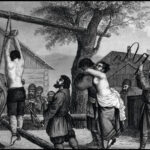Quote:
For sale, a prime lot of Gypsy slaves, to be sold by auction at the Monastery of St. Elias, 8 May 1852, consisting of 18 men, 10 boys, 7 women and 3 girls: in fine condition.
Source:
Quote: Ian Hancock (1987): The Pariah Syndrome. An Account of Gypsy Slavery Tucson: Karoma Pub.
Picture: ORF
Author Bio:
Ian Hancock (born 1942), who is Romani, researched this quote from 1852. In 1971 he was awarded a PhD despite not having a high school diploma. He subsequently became a professor at the University of Texas and opened the Romani Archive and Documentation Centre, which contains over 10,000 titles on the subject of Rrom*nja and Sinte*zza. His book The Pariah Syndrome is one of the few to provide a historical account of Romanian Rrom*nja slavery.
Context:
 While slavery had been forbidden in Europe since the early Middle Ages, the serf system (Federici, 2014: 27) continued to exist. The fact that 14th century Romanian chronicles first mention Romn*ja as “objects” in monasteries suggests another reality: that both the royal family and nobility enslaved them. Even in monasteries, one could find enslaved Romn*ja working in different professions, as blacksmiths, miners, cooks, field workers or musicians.
While slavery had been forbidden in Europe since the early Middle Ages, the serf system (Federici, 2014: 27) continued to exist. The fact that 14th century Romanian chronicles first mention Romn*ja as “objects” in monasteries suggests another reality: that both the royal family and nobility enslaved them. Even in monasteries, one could find enslaved Romn*ja working in different professions, as blacksmiths, miners, cooks, field workers or musicians.Further Reading:
*Silvia Federici (2014): Caliban and the Witch. Women, the Body and Primitive Accumulation. New York: Autonomedia.
Year:
1852